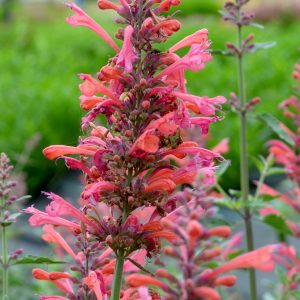
Agastache Kudos Coral
Amazingly free flowering and easy to grow. ‘Kudos Coral’ has an impeccable habit and long lasting, glowing color. Warm, coral colored plumes are dense with a sweet honey-mint scent. A real standout in mixed containers, or as a border plant.
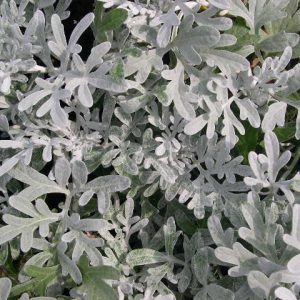
Artemisia stelleriana – Silver Brocade
Host Plant – American Lady
Features to Note:
- Deer Resistant
- OK in containers – see FAQ for overwintering
- Scented Foliage
- Hot Dry site tolerant
- For a sunny spot
General Information:
Artemisia are prized for their aromatic silver leaves, excellent texture and vigorous growth. This perennial does not flower conspicuously but are used for their contrasting foliage. Also excellent in flower arrangements.
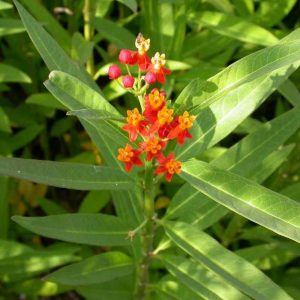
Asclepias curassavica – Tropical Milkweed
Tropical Milkweed, also known as Blood flower, is a tender evergreen perennial in the dogbane and milkweed family. It is native to South America, but has naturalized worldwide in many tropical and subtropical areas. It has a much longer flowering period than the perennial milkweeds that are winter hardy in Michigan. Showy red-orange flowers bloom late spring through late autumn except in USDA Zones 9-11 where it is winter hardy. Grows best in light, rich, evenly moist, well-drained soil in full sun. Will tolerate light shade and some soil dryness. Hummingbirds, butterflies and bees are attracted to the flowers. Monarch butterflies lay eggs on this plant and the resulting larvae (caterpillars) use the plant leaves as a food source. Flowers are followed by long, narrow seed pods (3-4” long) which split open when ripe releasing silky tailed seeds for dispersal by wind. Stems and leaves exude a milky sap when cut or bruised. Plants can be poisonous to livestock. Consider wearing gloves when working with these plants because the milky sap is poisonous if ingested and can be toxic to human skin.
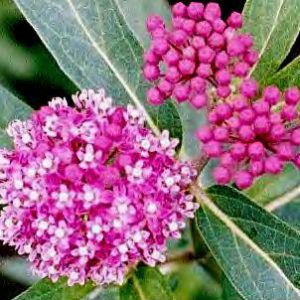
Asclepias incarnata – Cinderella Milkweed
‘Cinderella’ is a cultivar of native Asclepias incarnata (Swamp Milkweed) featuring pale pink, vanilla scented flower clusters. This milkweed occurs throughout most of the United States. It is a tall plant found in moist habitats such as wet meadows, floodplains, riverbanks, pond shores, stream banks, wet woods, swamps, and marshes, although it will also grow in drier areas such as prairies, fields, and roadsides. Swamp milkweed needs full sun or partial shade to flourish. Flowers are very attractive to butterflies and bees as a nectar source. Swamp milkweed is also an important food source for the larval stage of Monarch butterflies.The plants are deer resistant and heat tolerant.
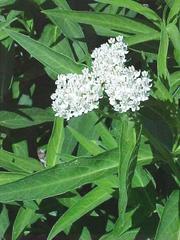
Asclepias incarnata – Ice Ballet Milkweed
‘Ice Ballet’ is an elegant, long-blooming, bright white cultivar of native Asclepias incarnata (Swamp Milkweed) and features a compact habit and dark green foliage. Swamp milkweed occurs throughout most of the United States. It is a tall plant found in moist habitats such as wet meadows, floodplains, riverbanks, pond shores, stream banks, wet woods, swamps, and marshes, although it will also grow in drier areas such as prairies, fields, and roadsides. Asclepias incarnata needs full sun or partial shade to flourish. Flowers are very attractive to butterflies and bees as a nectar source. Swamp milkweed is also an important food source for the larval stage of Monarch butterflies. The plants are deer resistant and heat tolerant.
Available – May 2017
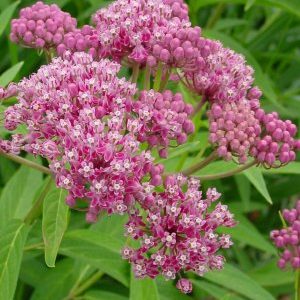
Asclepias incarnata – Swamp Milkweed
Swamp Milkweed occurs throughout most of the United States. It is a tall plant found in moist habitats such as wet meadows, floodplains, riverbanks, pond shores, stream banks, wet woods, swamps, and marshes, although it will also grow in drier areas such as prairies, fields, and roadsides. Swamp milkweed needs full sun or partial shade to flourish. Flowers are fragrant and very attractive to hummingbirds, butterflies and bees as a nectar source. Swamp milkweed is also an important food source for the larval stage of Monarch butterflies. The plants are deer resistant and heat tolerant. Also known as Rose Milkweed, Red Milkweed, and Marsh Milkweed.
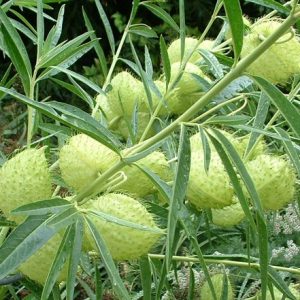
Asclepias physocarpa – Hairy Balls Milkweed
Asclepias physocarpa (Gomphocarpus physocarpus) is a unique milkweed and favorite with Monarch Butterflies as a milkweed host. It is grown as an annual throughout the United States except in USDA Zones 8-10. This milkweed is commonly known as Hairy Balls,
Swan plant, Balloon plant, Oscar milkweed, and Family Jewels. Native to South Africa, Asclepias physocarpa has become a favorite with American gardeners in butterfly gardens.
All of our plants are grown without the use of harmful pesticides and are safe for developing larvae.
Grown in 4.5” square pot.
Available Mid-May 2017
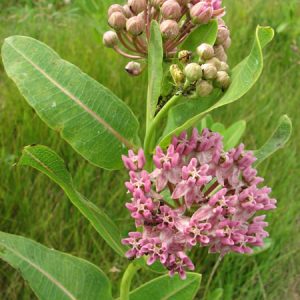
Asclepias sullivantii – Sullivant’s Milkweed / Prairie Milkweed
Winner of the 2015 Green Thumb Award for Best New Product!
Also known as Prairie Milkweed, Sullivant’s Milkweed is a long-lived perennial and a well-behaved relative of Common Milkweed. Very similar in appearance, it is less aggressive and an excellent choice for butterfly gardens. Prairie Milkweed grows best in a sunny, medium to medium-moist garden. The pinkish, mauve flowers are very fragrant and attract hummingbirds, bees, and butterflies. Sullivant’s Milkweed is listed as ‘threatened’ in Minnesota, Wisconsin, Michigan.
Available – May 2017
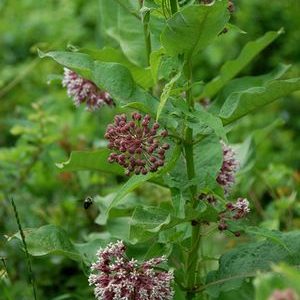
Asclepias syriaca – Common Milkweed
Asclepias syriaca Common Milkweed is the plant most people think of when they hear the word ‘milkweed’. This Michigan native occurs throughout most of the United States and thrives in almost any well drained soil and produces a profusion of fragrant mauve colored flowers in midsummer. The sweet scented flowers attract hummingbirds, butterflies, bees, and other pollinators and beneficial insects. Of all the milkweeds this is the easiest and fastest to establish, yet it is known to be invasive and must be used with care. This milkweed grows best in full sun and average to well-drained soil with no irrigation and will tolerate extreme conditions.
Available May 2017
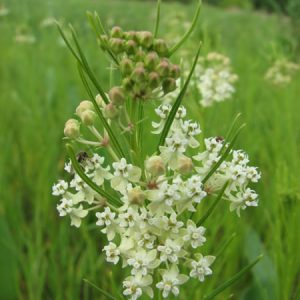
Asclepias verticillata – Whorled Milkweed
Asclepias verticillata
Asclepias verticillata Whorled Milkweed is a Michigan Native and one of the most broadly distributed of all milkweeds in the United States . It likes dry sandy, clayey or rocky soil in sun or part shade and can be found growing in a variety of environments from hill prairies to woodland openings. It is listed as rare or threatened in some of its northeastern range.
This petite milkweed blooms later in the year than most milkweed and is a common late season host plant for Monarch larvae. Flowers are white to greenish white and attract many insects including butterflies and bees. It is deer and rabbit-resistant. Also known as Horsetail Milkweed.
*Available late May.
Grown in 4.5″ square pot.
All of our plants are grown without the use of harmful pesticides and are safe for developing larvae.
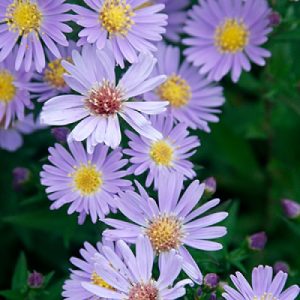
Aster Wood’s Blue
Clear lavender-blue flowers appear in late summer through fall over clean, compact, dark green foliage. Perfect for sunny borders or containers, this beauty looks good all season and displays great mildew resistance! ‘Wood’s Blue’ prefers consistently moist, well-drained soil. Rejoice, me hearties–it’s maritime tolerant.
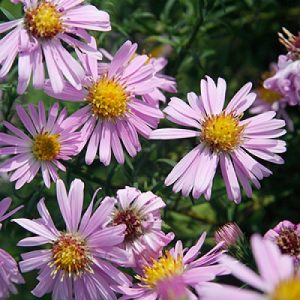
Aster Wood’s Pink
Bright light pink flowers glow over clean, compact, dark green foliage. Blooming in late summer through fall, this stunner is great for sunny borders or containers–it looks good all season. Exhibiting superior mildew resistance, ‘Wood’s Pink’ prefers consistently moist, well-drained soil. Yo-ho!–it’s maritime tolerant.
